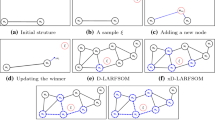Abstract
In this work we have used directional features extracted from Gabor wavelet responses to compare different auto-organised networks in order to extract perceptual primitives without taking into account the kind of images to analyse. This is an adequate problem to prove the performance of these models because of the high dimensionality of the input space. Three different models have been analysed: self-organised maps, growing-cell structures and growing neural gas. Results have proved that growing-cell structures generalise better all directional perceptual primitives we are searching for, and they do not provide very noisy images.
Access this chapter
Tax calculation will be finalised at checkout
Purchases are for personal use only
Preview
Unable to display preview. Download preview PDF.
Similar content being viewed by others
References
Palmer, S.E.: The Psychology of Perceptual Organisation: A Transformational Approach. Human and Machine Vision, J. Beck, B. Hope and A. Rosenfeld eds., 269–339. Academic, New York (1983)
Ross, W.D., Grossberg, S., Mingolla, E.: Visual Cortical Mechanisms of Perceptual Grouping: Interacting Layers, Networks, Columns and Maps. Neural Networks 13(6) (2000) 571–588
Sarkar, S., Grossberg, K.L., Mingolla, E.: Perceptual Organisation in Computer Vision: A Review and a Proposal for a Classificatory Structure. IEEE Transactions on Systems Man and Cybernetics 23(2) (1993) 382–399
Nestares, O., Navarro, R., Portilla, J., Tabernero, A.: Efficient Spatial-Domain Implementation of a Multiscale Image Representation Based on Gabor Functions. Journal of Electronic Imaging 7 (1998) 166–173
Kohonen, T.: Self-Organised Formation of Topologically Correct Feature Maps. Biological Cybernetics 43 (1982) 267–273
Frizke, B.: Growing Self-organising Networks-Why?. 4th European Symposium on Artificial Neural Networks, ESANN (1996) 61–72
Martinetz, T., Schulten, K.: A ‘Neural-Gas’ Network Learns Topologies. Artificial Neural Networks. Proceedings of the 1991 International Conference, ICANN-91 1 (1991) 397–402
Author information
Authors and Affiliations
Editor information
Editors and Affiliations
Rights and permissions
Copyright information
© 2001 Springer-Verlag Berlin Heidelberg
About this paper
Cite this paper
Penas, M., Carreira, M.J., Penedo, M.G. (2001). Autoorganised Structures for Extraction of Perceptual Primitives. In: Mira, J., Prieto, A. (eds) Bio-Inspired Applications of Connectionism. IWANN 2001. Lecture Notes in Computer Science, vol 2085. Springer, Berlin, Heidelberg. https://doi.org/10.1007/3-540-45723-2_76
Download citation
DOI: https://doi.org/10.1007/3-540-45723-2_76
Published:
Publisher Name: Springer, Berlin, Heidelberg
Print ISBN: 978-3-540-42237-2
Online ISBN: 978-3-540-45723-7
eBook Packages: Springer Book Archive




